| Day | Activity | Overnight Stay |
|---|---|---|
| 1 | Arrive in Buenos Aires, city tour | Buenos Aires |
| 2 | Buenos Aires - La Boca | Buenos Aires |
| 3 | Flight to El Calafate | El Chalten |
| 4 | Hiking: Laguna de Los Tres | El Chalten |
| 5 | Hiking: Loma del Pliegue Tumbado | El Chalten |
| 6 | Day trip to Lago Del Desierto - Bus to El Calafate | El Calafate |
| 7 | Perito Moreno | El Calafate |
| 8 | Day trip to Torres del Paine | El Calafate |
| 9 | Flight to Puerto Iguazu | Puerto Iguazu |
| 10 | Iguazu Falls: Argentinian side | Puerto Iguazu |
| 11 | Iguazu Falls: Brazilian side - Flight to Buenos Aires | Buenos Aires |
| 12 | Flight to Santiago de Chile | Santiago |
| 13 | City tour Santiago | Santiago |
| 14 | Cajon del Maipo | Santiago |
| 15 | Valparaiso | Santiago |
| 16 | Day trip to Aconcagua National Park | Santiago |
| 17 | Flight to Montevideo | Montevideo |
| 18 | City tour Montevideo | Montevideo |
| 19 | Colonia de Sacramento - Ferry to Buenos Aires | Buenos Aires |
| 20 | Flight back home | Home sweet home |
Days 1-2: Buenos Aires
Buenos Aires is a city of contrasts: old palaces, new style skyscrapers and colorful colonial architecture. In total, we spent a bit more than 2 days there, enough to get accustomed to the language and the South American culture, to eat delicious steaks and drink enough glasses of Malbec wine.
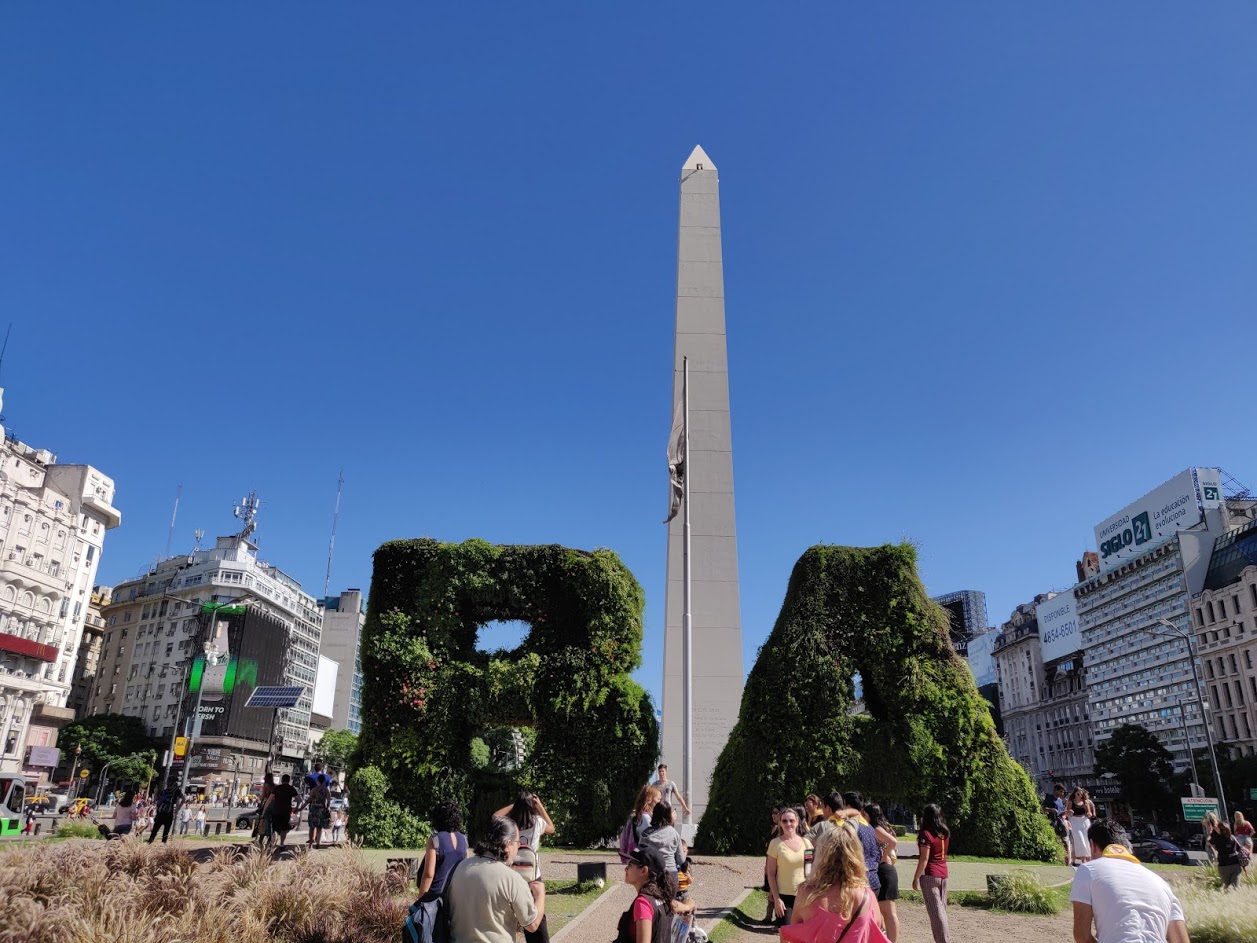
First time in a new city on a new continent after a long flight (ours was 14 hours from Frankfurt)? Hop on a 4 hour free walking tour through the central part of Buenos Aires! Our guide was really nice, but our group was pretty big, so we moved slowly through the streets of Recoleta, plaza San Martin and the rest of the central neighbourhoods of Buenos Aires. As the tour ended, we continued our walk towards Plaza de Mayo and Puerto Madero.
Recommended activities
- Visit the world renown Teatro Colon
- Recoleta Cemetery and the tomb of Eva Peron
- Plaza de Mayo, with the famous Casa Rosada
- Avenida 9 de Julio, (arguably) the widest street in the world
- Walk along the canal in Puerto Madero
A very good way to start your day in Buenos Aires is with a typical (and heavy) porteño breakfast at Cafe Tortoni. That's what we also decided to do, early in the morning, to get ready for a lot of walking through the streets of La Boca.
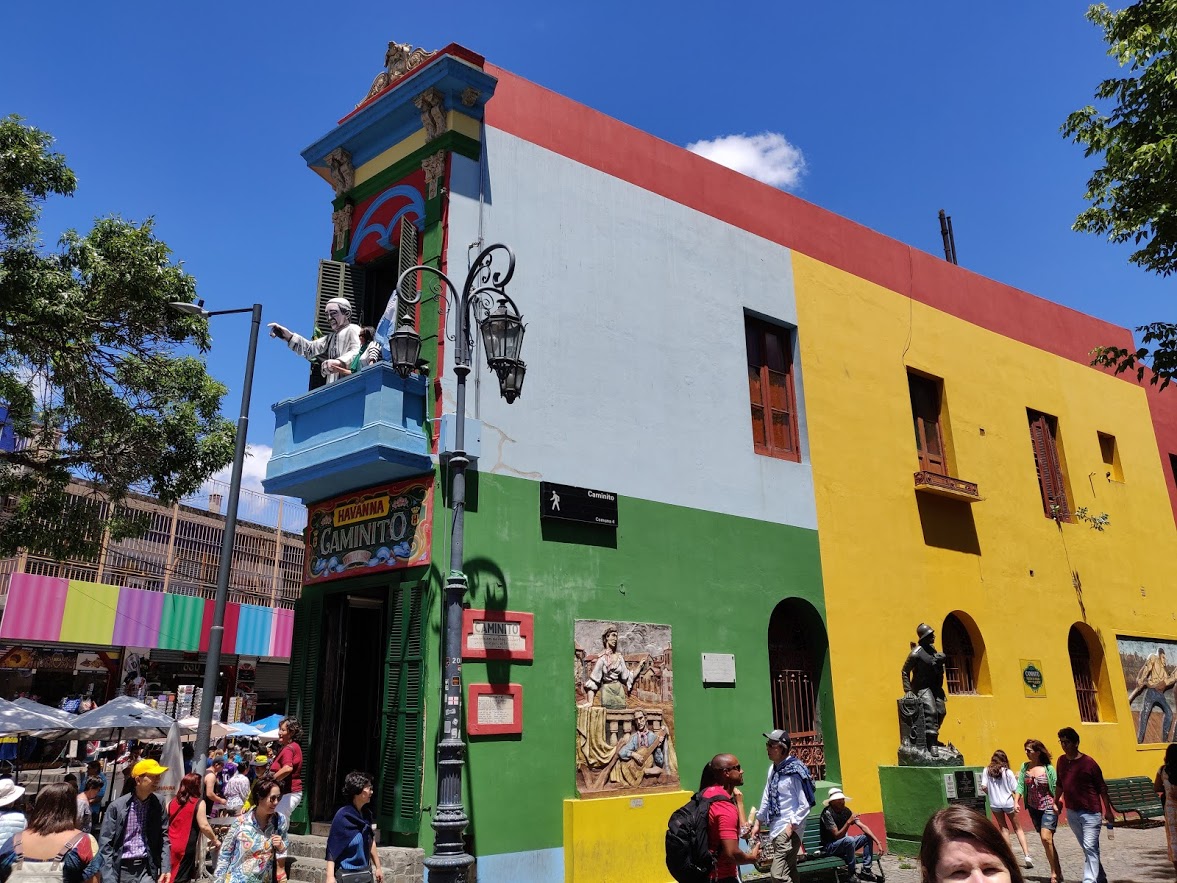
This neighbourhood almost deserves its own chapter, due to its colorful houses and street art. We took an entire Sunday morning to walk around the relatively small "barrio". Make sure you don't miss the area around "La Bombonera" Stadium, home of the Boca Juniors, arguably the team with the most passionate fans in the world.
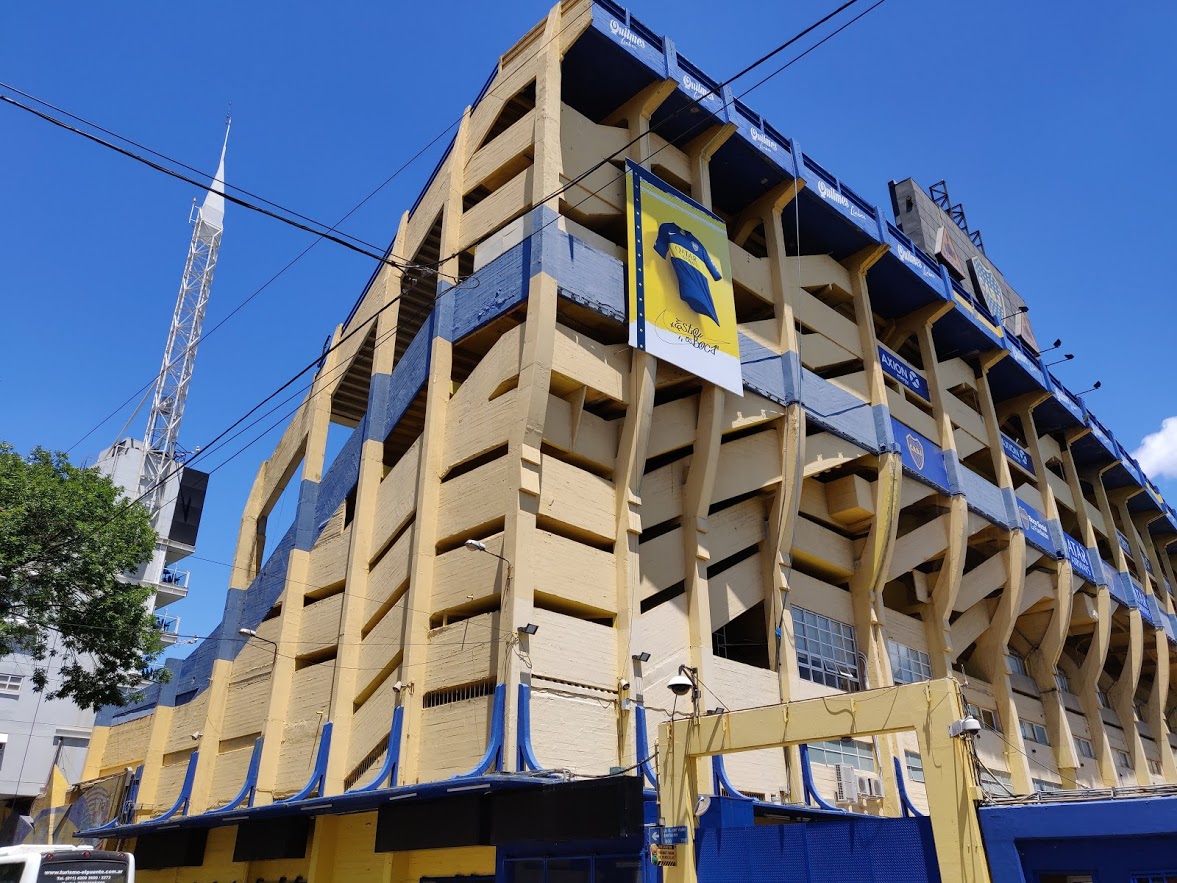
If you decide to walk from La Boca back towards the city center, you will pass through San Telmo, another neighbourhood of Buenos Aires, famous for its Sunday flee market.

Something that you don't want to miss while in Buenos Aires is a tango show. Even if it might seem to be a tourist trap, if you choose a good one, you'll get to see authentic Argentinian tango and listen to local musicians in a very nice atmosphere. We opted for a dinner and tango show at Teatro Astor Piazzolla and fully enjoyed it.
Days 3-8: Patagonia
From Buenos Aires, we took a plane to El Calafate and then a bus to El Chalten. There, we stayed for 3 days, hiking in the mountains around the "capital of hiking" of Argentina. In total, we spent 5 full days in Patagonia, including a day trip to the Chilean side, hiking and sightseeing around some of the most amazing landscapes we ever saw, at the southern end of the world!
El Chalten
In El Chalten, we were very lucky and had good weather for hiking, so we had two amazing full day hikes to Laguna de los Tres and to Loma del Pliegue Tumbado. We also had a half-day trip to the nearby Lago del Desierto. For more details on these, see our Hiking in El Chalten spotlight article.
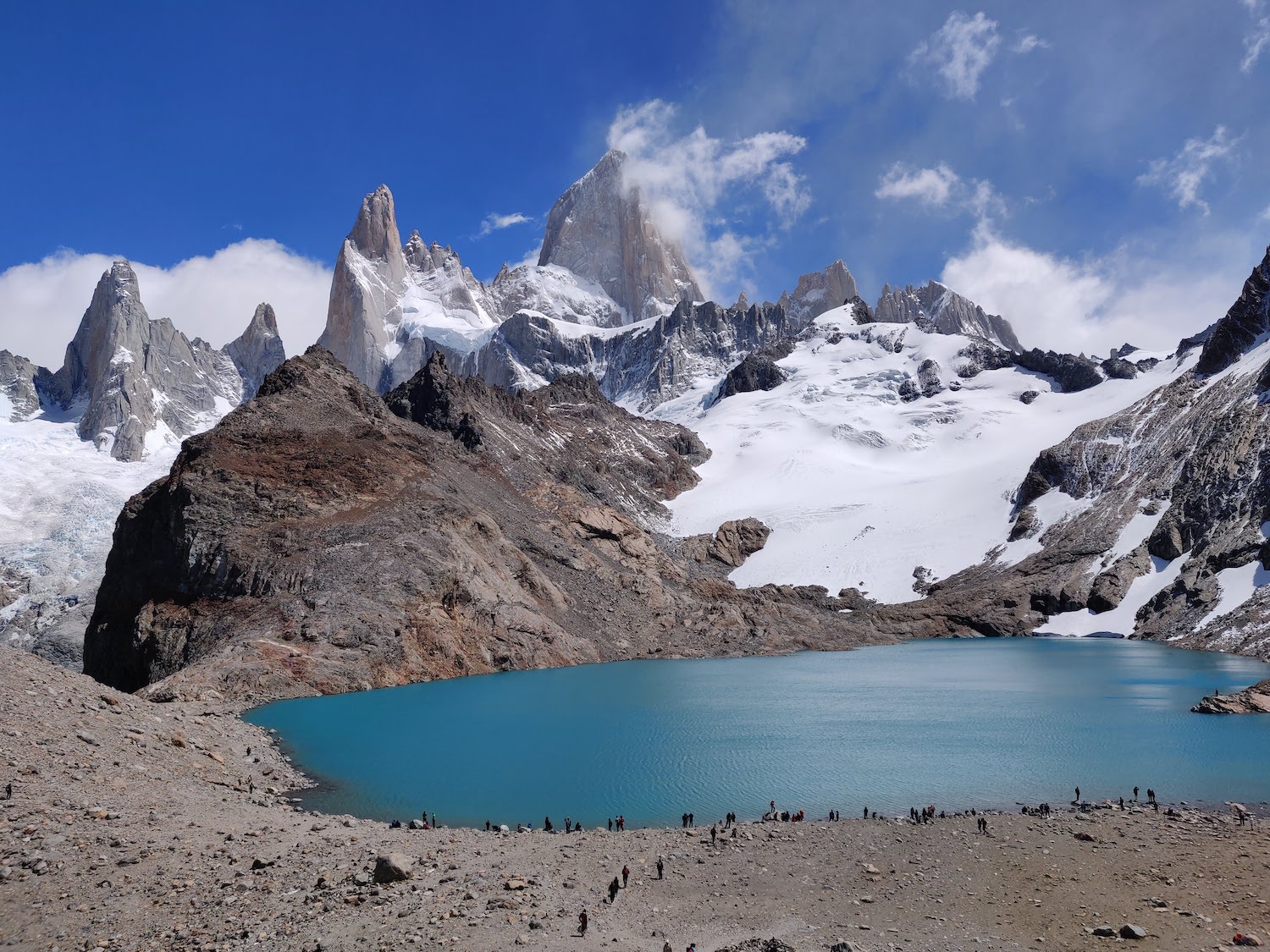
After our trip to Lago Del Desierto, we took a bus back to El Calafate, where we "set camp" for the next 3 nights.
Perito Moreno
The must-do thing while in El Calafate is go to the amazing Perito Moreno glacier. Patagonia has a lot of glaciers and while Perito Moreno is not the biggest, it is definitely the most popular, due to its accessibility. We booked a tour with Hielo y Aventura, on a day in which we saw the glacier from all possible angles and viewpoints and we embarked on a short hike on the glacier itself!
We arrived in the national park and we boarded a medium-size boat to cruise on Lago Rico, to the foot of the glacier. Here, we hiked for an hour and a half on the glacier itself, using ice crampons, on the white-blue ice, around creases and water streams. Really a unique experience which we definitely recommend.
The team that runs the tour is very professional and they spend a lot of time showing you how to hike on the glacier. Overall, it's a low effort activity that is recommended to everyone, even if you are not feeling fit enough to do it. How many times do you have the opportunity to walk on a glacier?
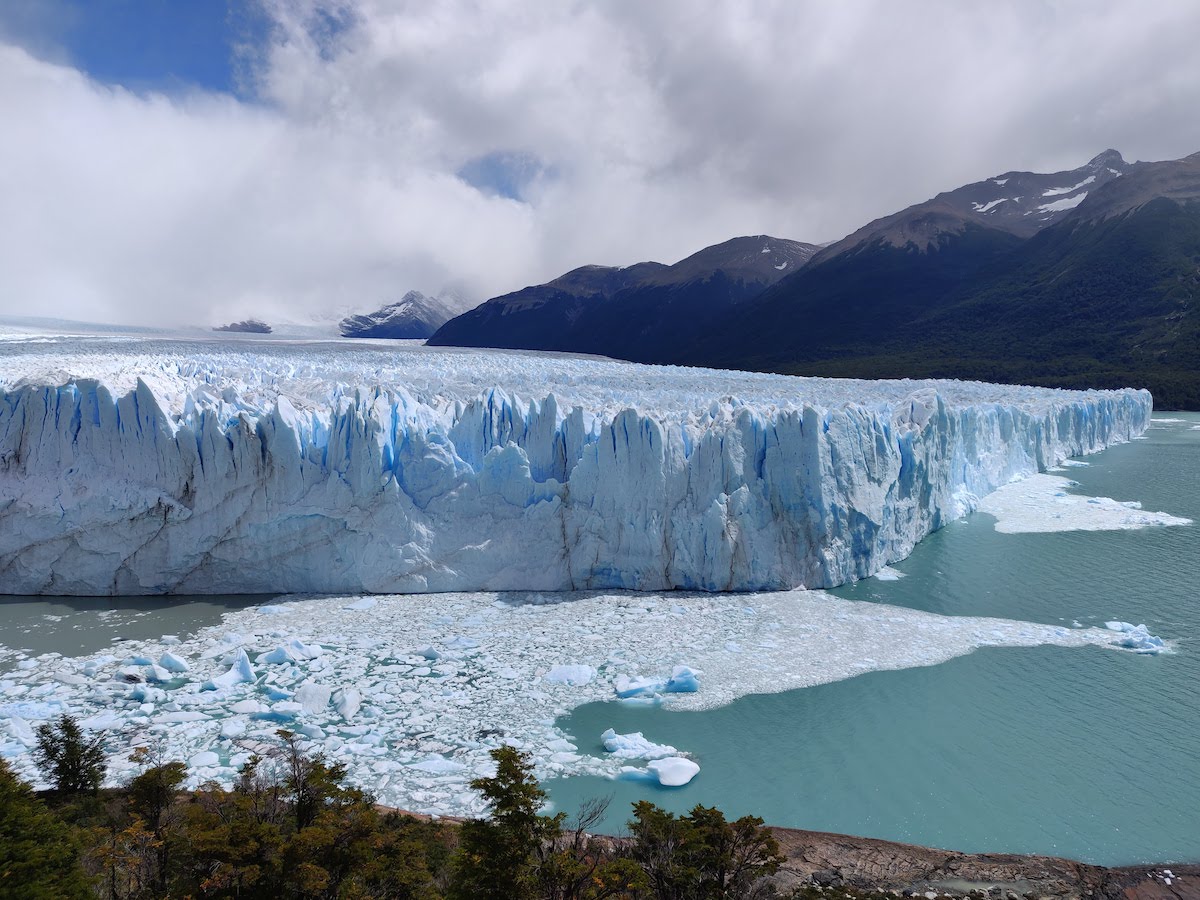
The last part of the tour includes some time at the Perito Moreno balconies. These are wooden walkways right in front of the glacier. From here you can really grasp the sheer size of the glacier, while you are listening to the roar of the ice as it raptures.
Torres del Paine
For our last day in Patagonia, we really wanted to catch a glimpse of the Chilean side and we booked a day trip from El Calafate to the famous Torres del Paine National Park. A single day is not enough to do justice to this spectacular area, but we enjoyed every moment spent here.
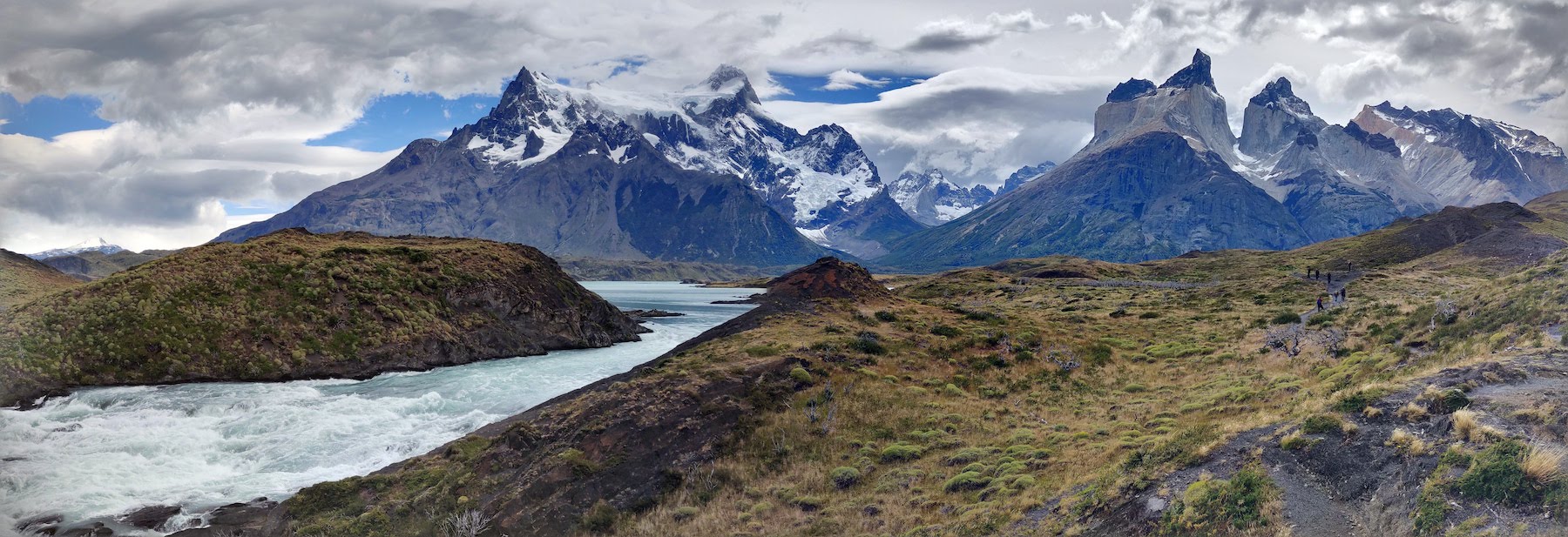
A lot of tourists flock to this national park and embark on multi-day treks around the mountains. We will definitely come back here with more time to enjoy the amazing landscape.
In our limited time at the site, we enjoyed the majestic jump of Salto Grande, the biggest waterfall in the park and we admired the mountains from the shore of milky-green lake Pehoé. The park also has a big population of Guanacos, cute camelids closely related to llamas, that you see virtually everywhere.
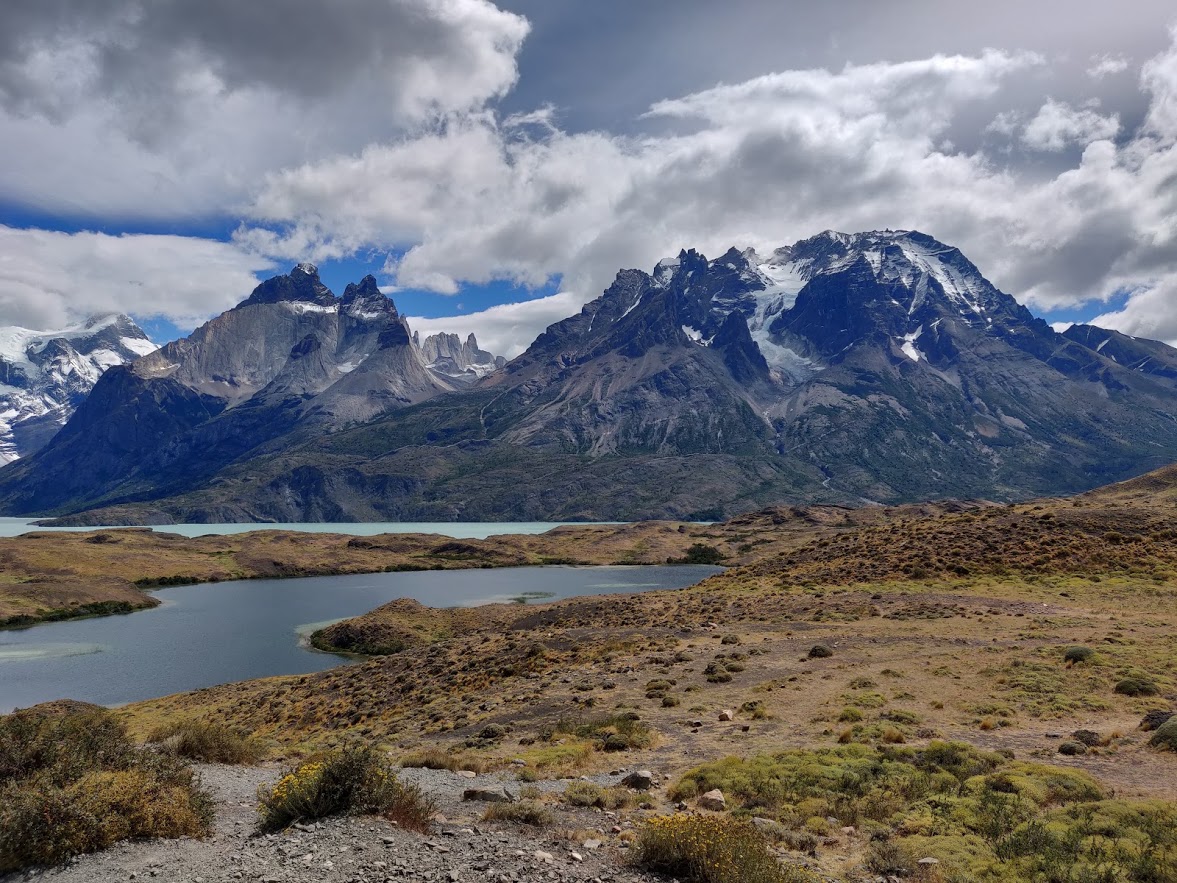

Days 9-11: Iguazu Falls
After hiking in the cold Patagonian weather, we moved to the north of Argentina in the tropical lands. We flew from El Calafate to Puerto Iguazu (via Buenos Aires), and were welcomed with a heavy tropical rain and 35°C.
In total, we spent two days to admire one of the most spectacular waterfalls in the world: Iguazu Falls. We made sure to have enough time to visit both the Argentinian and the Brazilian side of the falls.
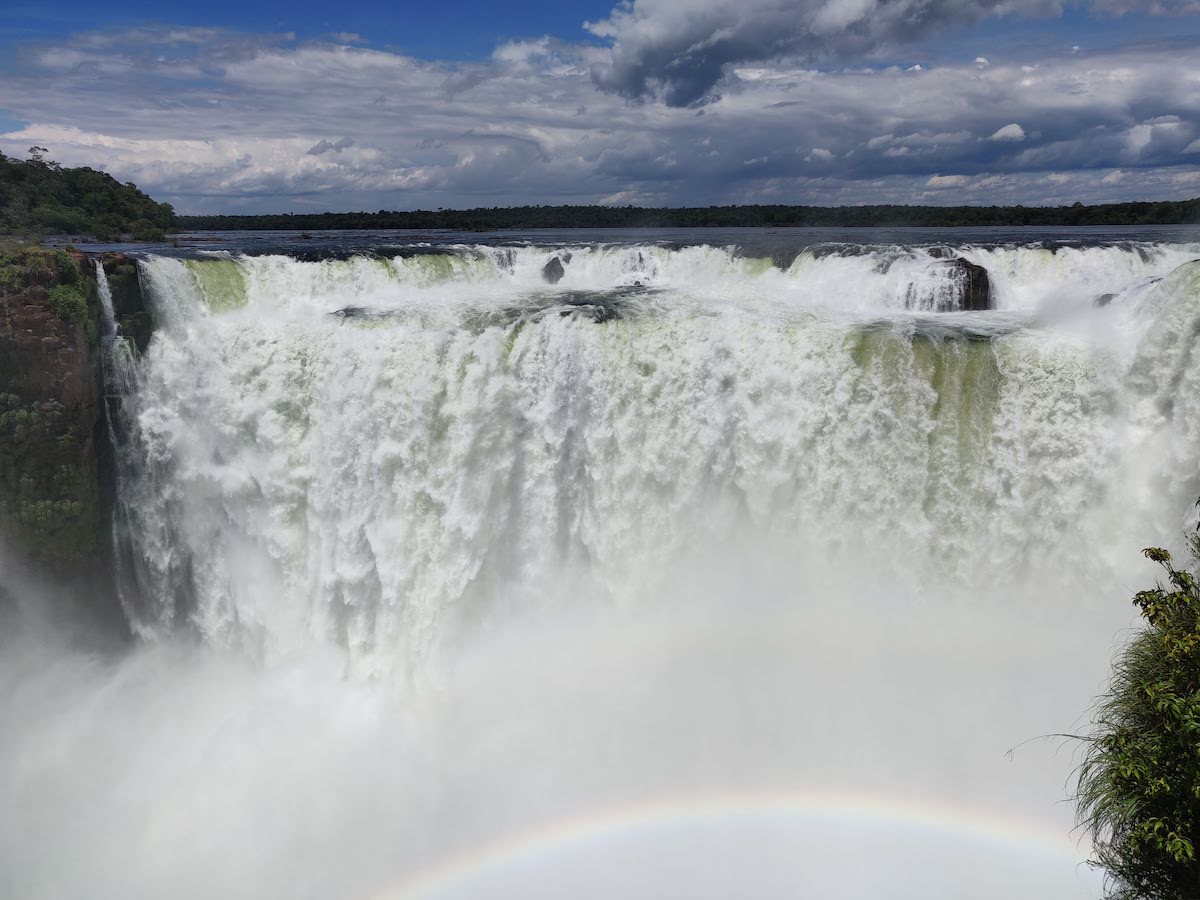
Long story short: you will get wet! It's hard to describe the falls. Words simply don't do justice! You have to experience being meters away from a 70m fall, getting splashed by the constant water vapors rising from the Devil's Throat, the most famous section of the falls.
To find our more about visiting Iguazu on both the Argentinian and Brazilian side, read our Two sides of Iguazu Falls spotlight article.
Days 12-16: Central Chile
From the tropical jungle, our next stop was in central Chile, where we stayed for 5 days. On a clear day, flying towards Santiago, you get a glimpse of the size of the Andes around the central part of Chile and Argentina, with peaks going over 6000m as you are at the regular 10000m altitude. Right under the wing of the plane, you can catch a glimpse of Cerro Aconcagua - 6960m, the highest mountain in the world outside the Himalayan range and the highest peak in the southern and eastern hemispheres.
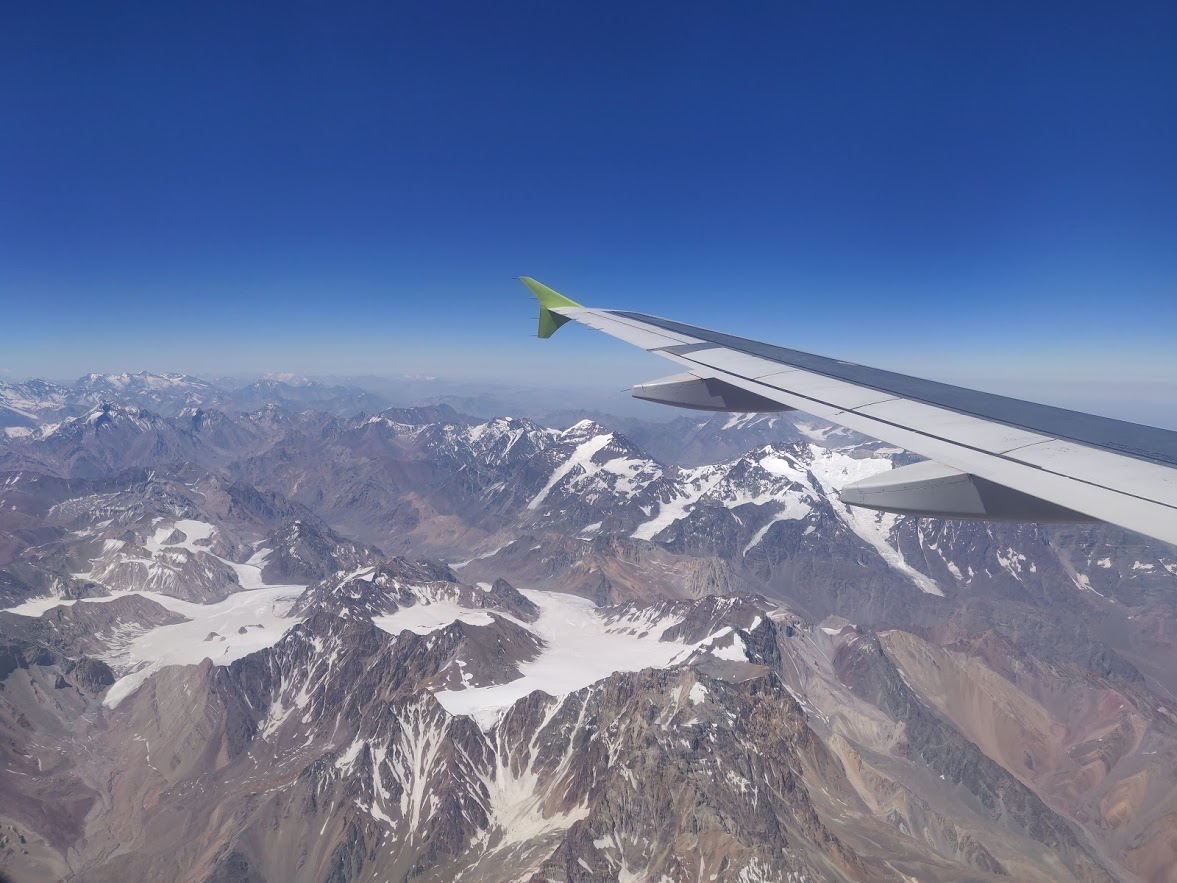
Santiago
First time in a new city? Hop on to a free walking tour! We had a great time with our guide, Felipe, walking around the busy streets in the center of the city, getting acquainted with the history and culture around Santiago. In total, we spent 2 days in the city, which is more than enough to get a good feel of it. The weather this time was scorching hot, with 39°C in the sun. Luckily, the city is full of parks and pedestrian streets, so overall the experience was pleasant.
Recommended activities:
- Plaza de Armas and the central pedestrian streets of Santiago
- La Moneda, the presidential palace
- A nice walk around Bellavista, where you can find one of Pablo Neruda's houses
- The funicular and/or cable car ride up and down Cerro Cristobal with an impressive view of the city
- Museum of Memory and Human Rights, commemorating the victims of the Pinochet era
At the end of a full day in Santiago, we had a great evening at Bocanariz Vinobar, tasting some local Chilean wines, much recommended!


Cajon del Maipo
Being so close to the Andes, we decided to visit the mountain area as well. We wanted to alternate the days in the city with the ones outside it, so spent our second day "in Santiago" outside of the city, on the beautiful Maipo river valley.
The highpoint of the day was a great hike to the foothills of the San Jose Volcano. The volcano itself is 5856m high and we hiked up to 3000m on a beautiful sunny day. The whole trip was flawlessly organized by AndoAndes and the guys were really awesome throughout the day. We had 3 guides for a group of 15 people, which says a lot about their dedication to provide quality services.
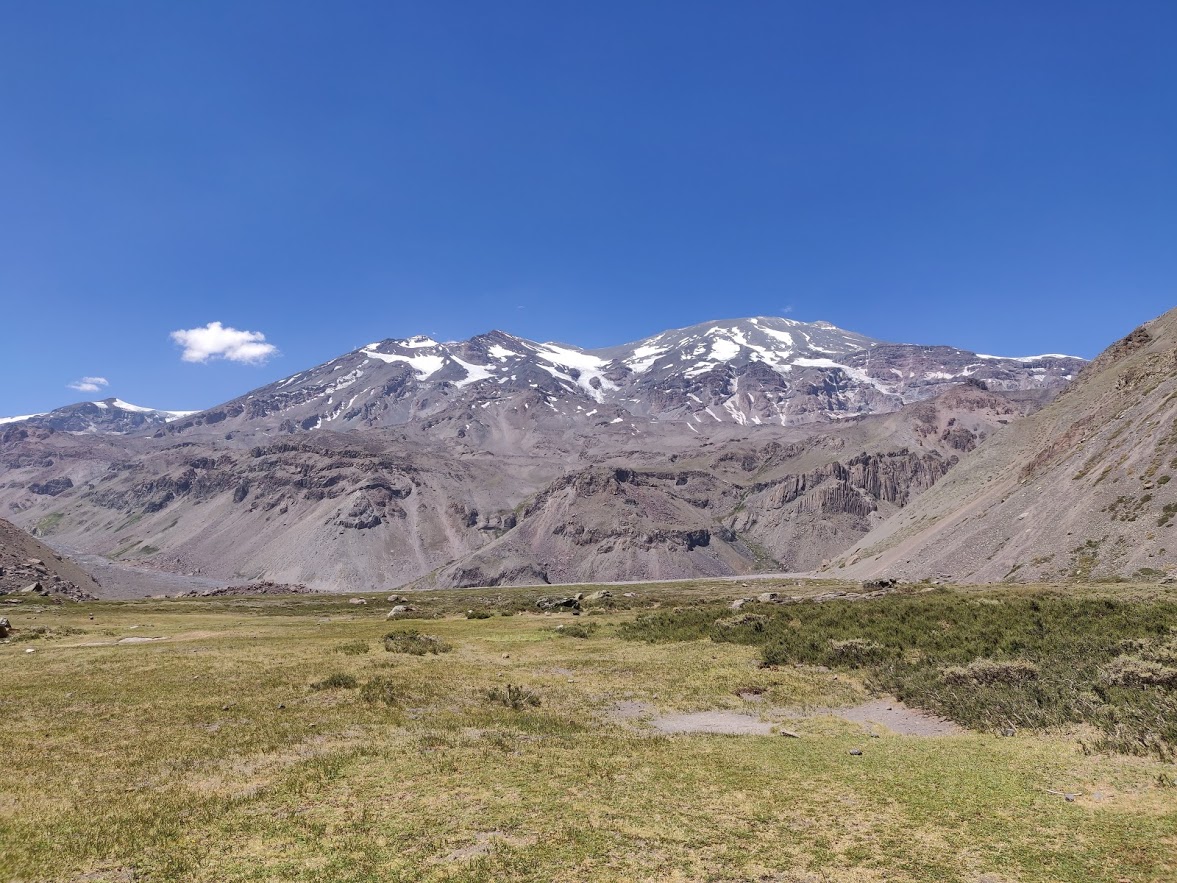
Valparaiso
For our next "inside the city" day, we decided to take a trip to Valparaiso, Chile's port on the Pacific Coast, world renown UNESCO World Heritage city. After a 90 minutes bus trip and a local bus to the old part of the town, we met the free walking tour group and we started going up and down the painted streets of Cerro Alegre and Cerro Concepcion.

The city is incredibly contrasting, from artsy painted houses and walls, to sketchy areas and a ton of stray dogs wondering around and following people in the tours. Nevertheless, our guide made sure we felt safe throughout the tour and looking back, it was a great experience.

One thing not to be missed in Valparaiso is riding the famous funiculars up and down the city hills. These are really old (but safe) installations that are actually incredibly useful for getting you from A to B faster.
Another spot to check is Cerro Artilleria, from where you can catch a great panoramic view of Valparaiso and its port as well as the Pacific coastline going up towards Viña del Mar. The later is a very popular beach destination in Chile, but we decided to skip it since the weather was not very friendly during the day.
The last thing you should check in Valparaiso is the public transport system. It is ridiculously cheap, heavily disorganized, almost chaotic, but it is a 100% authentic experience.
Aconcagua National Park
Our next day was again in the Andes, and it was again full of sunshine. This time we passed back into Argentina, on our way to the famous Aconcagua mountain and the national park with the same name.
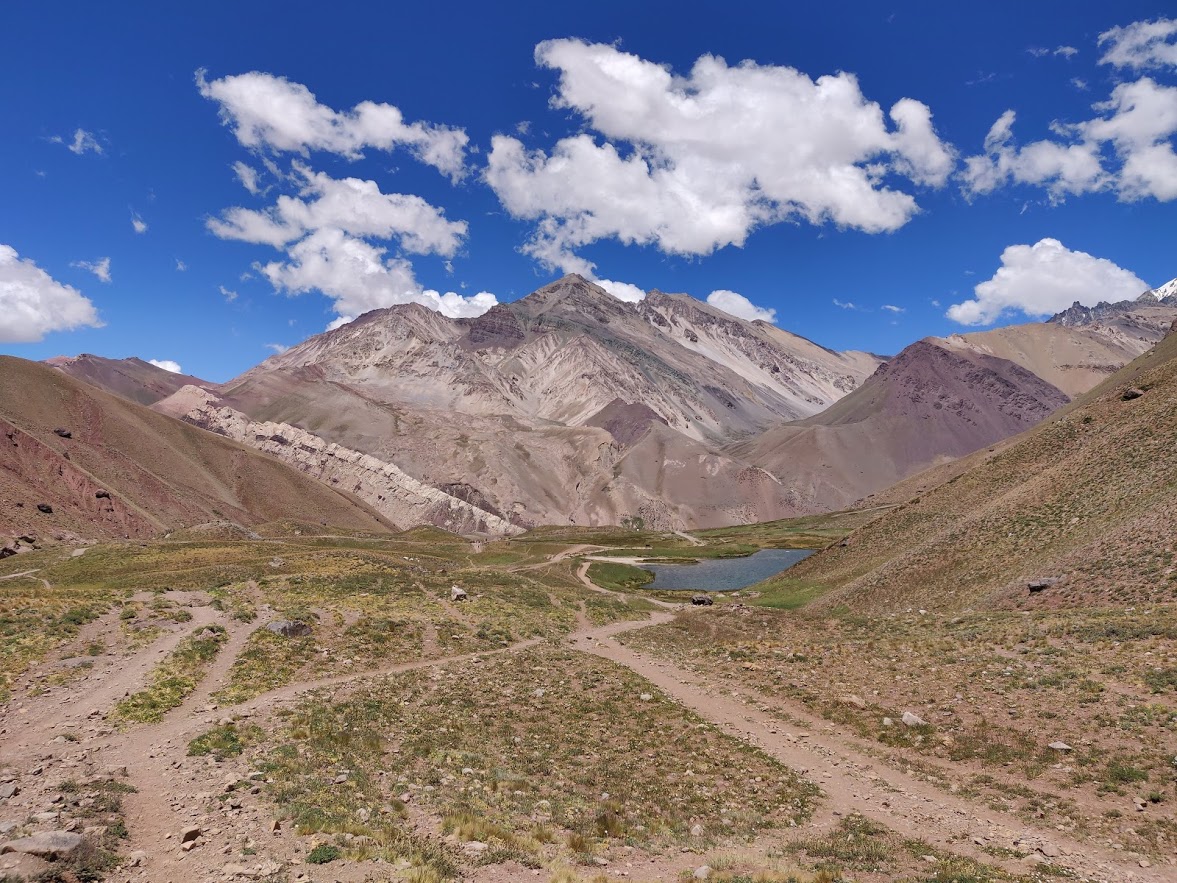
On the way, we stopped at Puente del Inca, a natural stone monument carved by the mountain stream. We had a smaller group this time, but we did waste a bit of time at the border controls in and out of Argentina.
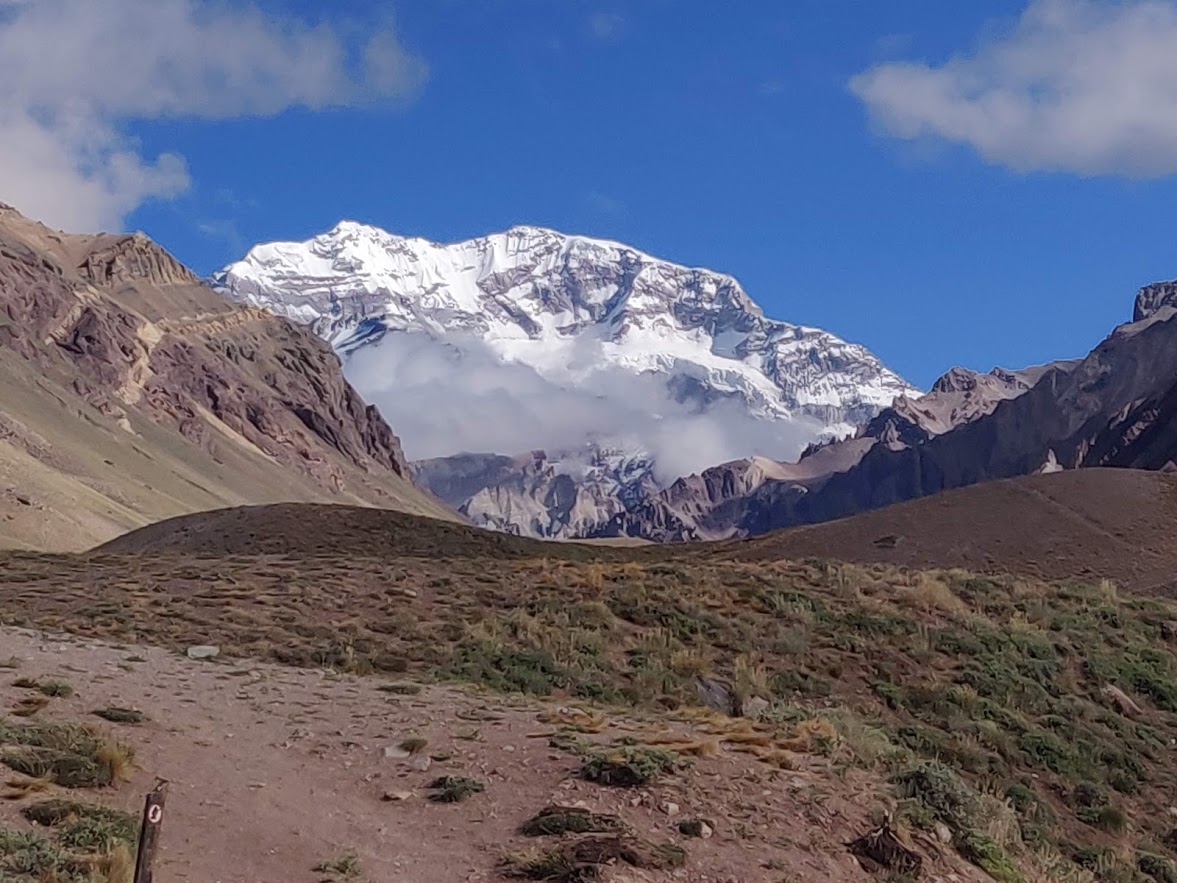
The landscape on the valley leading to Aconcagua is amazing and we had a 2 hour hike at around 3200m, with very little elevation, just enough to stretch our legs and get sleepy from the lack of oxygen. On the way back, we stopped on the Chilean side at Portillo, a famous ski resort extensively used by professional athletes during the summer season in the northern hemisphere.
Days 17-19: Uruguay
Uruguay is pretty different compared to the other countries we visited and feels much more peaceful and safer. Argentina and Chile are also safe, don't get us wrong, but Uruguay is what they call "the Switzerland of South America". People are very open minded and relaxed, but also super friendly towards visitors.
Montevideo
New city? Free walking tour :) We did the same in Montevideo. The group was quite big this time, but it was worth it, as we found out a lot about the history of Uruguay, while also visiting the old town.
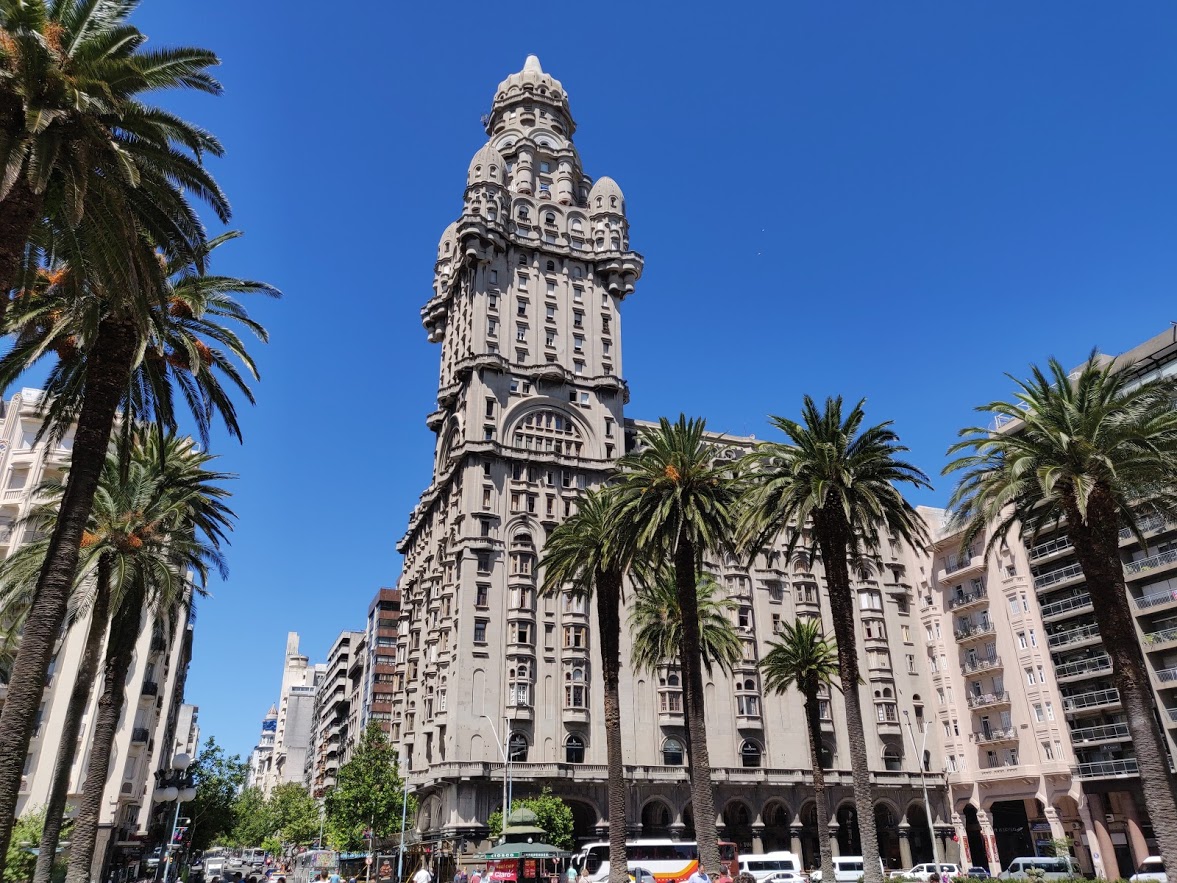
Two days in Montevideo are enough to see the old city, the port, the beach and overall just to enjoy the city. The plan for the final days was to relax more, so we took it easy.
Something to note is that in Uruguay the beef steak is as good as in Argentina, so make sure you try it out with a glass of local red wine.

Recommended activities:
- Sun bathing at Pocitos Beach
- Plaza Independencia with the impressive Palacio Salvo, the symbol of Montevideo
- Tour around Ciudad Vieja, with its nicely laid pedestrian streets
- Mercado del Puerto, the fish market next to the port
Colonia del Sacramento
On the way back to Buenos Aires, before crossing Rio de la Plata by ferry, we made our last stop in Colonia del Sacramento. We booked our ferry trip in such a way that we had 3 hours to kill in the small picturesque town before heading back to Argentina for our flight home. Colonia is a Portuguese colony from the 17th century and has a small but really cute UNESCO Heritage old town with the preserved colonial architecture.

Walking around gives you a feeling that time has stopped. Definitely a great way to end 3 weeks of travelling around South America.
Travel tips
We had a great time in all the countries we visited during this trip. It was a self-organized trip and we spent quite some time putting this schedule together.
We booked most our flights with Latam Airlines, since the reviews that we read on Aerolineas Argentinas spoke about big prices and a lot of delays. We also saw huge crowds waiting in line to board their planes in most of the airports in Argentina. We had no issues with Latam. Another company that we used was Sky Airline, a low cost airline which has a lot of flights in and out of Chile.
Flying in South America is expensive by today's standards, as fares do not come close to the low cost fares from Asia or Europe. If you plan your flights in advance, this won't be such a big issue. Keep in mind that Buenos Aires has two big airports when you schedule your trip.
You should check online if you have to pay any visa fees when you enter Argentina, Chile or Uruguay. Most of the European countries have a visa-free policy. You will get stamps in your passport every time you enter/exit a country so we collected quite a few in the 3 weeks spent there.
Each country has their own Pesos currency. The Argentinian Pesos (ARS) is devaluating fast in the past few years, so keep that in mind when you read about certain prices in ARS, as they change frequently.
To go from Montevideo to Buenos Aires, we took the ferry from Colonia. It was quite cheap and fast and is generally a much better option than flying.
To get from the airport to the city centers, we took taxis and sometimes we used Uber. We also used taxis for getting around the cities when the distances where too long to walk. They are safe and the prices are fair, quite cheap for European travellers. Unlike in other parts of the world, taxi drivers are especially funny and interested in where you come from. Every one of them asked us facts about Romania: economy, politics etc., after complaining about the corruption in their own country.
As a rule of thumb, we tried to find central hotels in each city, so that we were in walking distance of the main attractions. We tried to stay out of the main boulevards, to avoid the high traffic and noise.
Buenos Aires and Santiago are big cities, so naturally, some areas are more shady. Get accustomed with exchanging money on the street in Buenos Aires or with seeing homeless people in Santiago. We asked at the hotel and the tour guides if it's safe to walk in a certain area during the evening or night, and we were always told what to avoid.
Generally, expect a very nice and laid back atmosphere. Latino music is everywhere, and there's always someone that's humming the lyrics :).
People are very friendly. If you speak a bit of Spanish, or at least understand Spanish, everyone will help you: taxi drivers, hotel receptionists, waiters and random people on the street.
All in all, we'll definitely be back there some day.